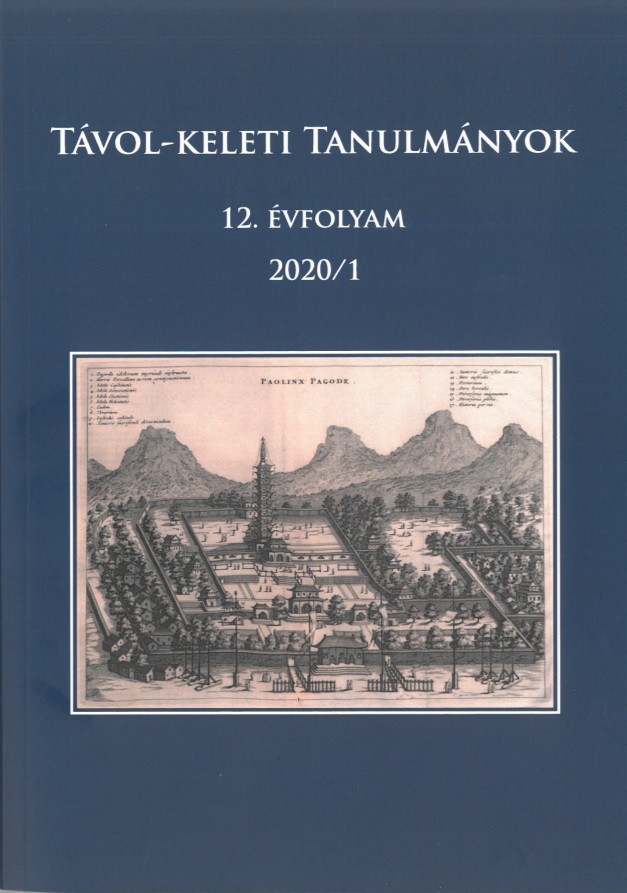Reviews
Chuluun, Sampildondov (ed.): Sar’dagiin khiid. Öndör Gegeen Zanabazariin uran büteeliin khüree. [A Sar’dagiin monostor. Öndör Gegeen Zanabazar művészetének temploma.]
Published 2021-02-25
How to Cite
Szilágyi, Z. (2021). Chuluun, Sampildondov (ed.): Sar’dagiin khiid. Öndör Gegeen Zanabazariin uran büteeliin khüree. [A Sar’dagiin monostor. Öndör Gegeen Zanabazar művészetének temploma.]. Journal of East Asian Cultures, 12(2020/1), 175–181. https://doi.org/10.38144/TKT.2020.1.9
Copyright (c) 2021 the author(s)

This work is licensed under a Creative Commons Attribution-NonCommercial 4.0 International License.
Abstract
Chuluun, Sampildondov (ed.): Sar’dagiin khiid. Öndör Gegeen Zanabazariin uran büteeliin khüree. [The Sar’dagiin Monastery. The Temple of the Art of Öndör Gegeen Zanabazar.] Ulaanbaatar, Shinjlekh Ukhaani Akademi, Tüükh, Ugsaatni Zuin Khüreelen, 2019. 488 pp.
References
- Bareja-Starzyńska, Agata 2008. „The Religious Authority of the First Jebzundamba of Mongolia (1635–1723).” In: Johan Elverskog ed.: Biographies of Eminent Mongol Buddhists. PIATS 2006: Tibetan Studies: Proceedings of the Eleventh Seminar of the International Association for Tibetan Studies, Königswinter. Halle: International Institute for Tibetan and Buddhist Studies. 47–55.
- Bareja-Starzyńska, Agata 2010. „The Mongolian Incarnation of the Jonangpa Tāranātha Kun dga’ snying po (1575–1634) — Öndör Gegeen Zanabazar Blo bzang bstand pa’i rgyal mtsan (1635–1723): A Case Study of the Tibeto-Mongolian Relationship.” Special Issue. Tibet Journal 34–35/2: 243–261.
- Bemman, Jan – Parzinger. Hermann – Pohl, Ernst – Tseveendorj, Damdinsüren (eds.) 2009. Current Archaeological Research in Mongolia. Bonn, Vor- und Fruhgeschichtliche Archaologie Rheinische Friedrich-Wilhelms-Universitat.
- Bemmann, Jan – Erdenebat, Ulambayar – Pohl, Ernst (eds.) 2009. Mongolian – German Karakotum Expedition. Wiesbaden, Reichert Verlag, 84–95.
- Harmath András – Laszlovszky József – Siklódi Csilla – Szilágyi Zsolt – Tolnai Katalin 2019. Under the Eternal Blue Sky. Landscape Archaeology in Mongolia. Budapest, Institute of Ethnology, Research Centre for the Humanities, Hungarian Academy of Sciences.
- Kradin, N. N. (ed.) 2011. Kidan’skij gorod Chintolgoj-balgas. Rossijskaya Akademiya Nauk, Moskva.
- Ochir, A. – Erdenebold, Lkh. – Enkhtör, A. 2015. „Isledovanya Kidanskyh gorodov gorodish i drugih soorizhenii v Mongolii.” [Kitan városok, települések és egyéb építmények kitatása Mongóliában.] In: Multidisciplinary Studies in Archaeology Vol. 2. Fortified towns and settlement sites. Vladivostok: Institute of History, Archaeology and Ethnography of the Peoples of the Far East. FEBRAS, 84-95.
- Pohl, Ernst – Mönkbayar, Lkh. – Arens, Birte – Frank, Klaus – Linzen, Sven – Osinska, Alexandra – Schüler, Tim – Schneider, Michael 2012. “Production Sites in Karakorumand its Environment: A New Archaeological Project in the Orkhon Valley, Mongolia.” Mongolian-German Karakorum Expedition https://www.researchgate.net/publication/264933194_Production_Sites_in_Karakorum_and_Its_Environment_A_New_Archaeological_Project_in_the_Orkhon_Valley_Mongolia (utolsó megtekintés: 2020. 10. 25.)
- Szilágyi, Zsolt 2015. „Shor Biography of Öndör Gegeen Zanabazar, the First Jebtsundamba khutagt.” In: Biratal, Á. – Majer, Zs. – Szilágyi, Zsolt – Teleki, K. (eds.): Buddhism in Mongolia. Traditional Mongolian Culture III. CD. Budapest, ELTE Dept. of Mongol and Inner Asian Studies – Research Center of Mongolian Studies.
- Szilágyi, Zsolt 2018. “Galdan’s Sacred Tree: The Historical Background of a Presen Day Sacral Cult.” Oyirad Studies (Oyirad Sudulul) 3: 28–37.
- Uranchimeg, Tsultemin 2019. “Buddhist Archaeology in Mongolia: Zanabazar and the Géluk Diaspora beyond Tibet.” Cross-Currents: East Asian History and Culture Review 31: 7–32. https://cross-currents.berkeley.edu/e-journal/issue-31/uranchimeg (utolsó megtekintés: 2020. 10. 24.)
- Yun Hyeung-Won (ed.) 2019. Heritage and Culture of the Mongols: Archaeological and Literary Monuments. Proceedings of the 3rd Asian Conference of IAMS. Seoul, The Korean Assotiation for Central Asian Studies – International Assotiatoin for Mongolian Studies.

